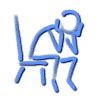American Psychiatric Association (1994). Diagnostic and Statistical Manual of Mental Disorders (4th ed.) Washington, DC: American Psychiatric Assoc.
The essential feature of Dysthymic Disorder is a chronically depressed mood that occurs for most of the day more days than not for at least 2 years. Individuals with Dysthymic Disorder describe their mood as sad or 'down in the dumps'. In children, the mood may be irritable rather than depressed, and the required minimum duration is only 1 year. During periods of depressed mood, at least 2 of the following additional symptoms are present: poor appetite or overeating, insomnia or hypersomnia, low energy or fatigue, low self-esteem, poor concentration or difficulty making decisions, and feelings of hopelessness. Individuals may note the prominent preseence and feelings of low interest and self-criticism, often seeing themselves as uninteresting or incapable becuse these symptoms have become so much a part of the individual's day-to-day experiences (p.346-7)

|
~~Diagnostic criteria for Dysthymic Disorder~~
A. Depressed mood for most of the day, for more days than not, as indicated either by subjective account or observation by others, for at least 2 years.
Note: In children and adolescents, mood can be irritable and duration must be at least 1 year.
B. Presence, while depressed, of two (or more) of the following:
(1) poor appetite or overeating
(2) insomnia or hypersomnia
(3) low energy or fatigue
(4) low self-esteem
(5)poor concentration or difficulty making decisions
(6) feelings of hopelessness
C. During the 2-year period (1 year for children or adolescents) of the disturbance, the person has never been without the symptoms in A and B for more than 2 months at a time.
D. No Major Depressive Episode has been present during the first 2 years of the disturbance (1 year for children and adolescents); i.e. the disturbance is not better accounted for by chronic
Major Depressive Disorder, or Major Depressive Disorder, in Partial Remission.
 Note: There may have been a previous Major Depressive Episode provided there was a full remission (no significant signs or symptoms for 2 months) before development of the Dysthymic Disorder. In addition, after the initial 2 years (1 year in children or adolescents) of Dysthymic Disorder, there may be superimposed episodes of Major Depressive Disorder, in which ase both diagnoses may be given when the criteria are met for a Major Depressive Episode. Note: There may have been a previous Major Depressive Episode provided there was a full remission (no significant signs or symptoms for 2 months) before development of the Dysthymic Disorder. In addition, after the initial 2 years (1 year in children or adolescents) of Dysthymic Disorder, there may be superimposed episodes of Major Depressive Disorder, in which ase both diagnoses may be given when the criteria are met for a Major Depressive Episode.
E. There has never been a Manic Episode, A Mixed Episode, or a Hypomanic Episode, and criteria have never been met for Cyclothymic Disorder.
F. The disturbance does not occur exclusively during the course of a chronic Psychotic Disorder, such as Schizophrenia or Delusional Disorder.
G. The symptoms are not due to the direct physiological effects of a substance (e.g. a drug of abuse, a medication) or a general medical condition (e.g. hypothyroidism).
H. The symptoms cause clinically significant distress or impairment in social, occupational, or other important areas in functioning.(p.349)
|

Hypomanic Episode* - a distinct period during which there is an abnormally and persistently elevated, expansive, or irritable mood that lasts at least 4 days. This period of abnormal mood must be accompanied by at least three additional symptoms from a list that includes inflated self-esteem or grandiosity (nondelusional), decreased need for sleep, pressure of speech, flight of ideas, distractability, increased involvement in goal-directed activities or psychomotor agitation, and excessive involvement in pleasurable activities that have a high potential for painful consequences. (p.335)
Manic Episode** - a distinct period during which there is an abnormally and persistently elevated, expansive, or irritable mood. This period of abnormal mood must last at least 1 week (or less if hospitalization is required). The mood disturbance must be accompanied by at least 3 additional symptoms from a list that includes inflated self-esteem or grandiosity, decreased need for sleep, pressure of speech, flight of ideas, distractibility, increased involvement in goal-directed activities or psychomotor agitation, and excessive involvement in pleasurable activities with a high potential for painful consequences. (p.328)
Mixed Episode*** - a period of time (lasting at least 1 week) in which the criteria are met both for a Manic Episode and for a Major Depressive Episode nearly every day. The individual experiences rapidly alternating moods (sadness, irritability, euphoria) accompanied by symptoms of a Manic Episode and a Major Depressive Episode. The symptom presentation frequently includes agitation, insomnia, appetite dysregulation, psychotic features, and suicidal thinking. (p.333)
Major Depressive Episode**** - a period of at least 2 weeks during which there is either dperessed mood or the loss of interest or pleasure in nearly all activities. In children and adolescents, the mood may be irritable rather than sad. The individual must also epxerience at least 4 additional symptoms drawn from a list that includes changes in appetite or weight, sleep, and psychomotor activity, decreased energy; feelings of worthlessness or guilt; difficulty thinking, concentrating, or making decisions; or recurrent thoughts of death or suicidal ideation, plans or attempts.. To count toward a Major Depressive Episode, a symptom must either be newly present or must have clearly worsened compared with the person's preepisode status. (p.321)
|




